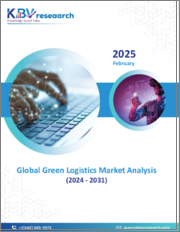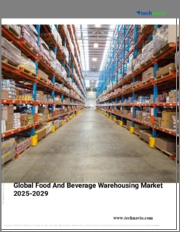
|
시장보고서
상품코드
1359038
스마트 창고 시장 예측(-2030년) : 컴포넌트별, 도입 모드별, 조직 규모별, 기술별, 용도별, 업계별, 지역별 세계 분석Smart Warehousing Market Forecasts to 2030 - Global Analysis By Component, Deployment Mode, Deployment Type, Organization Size, Technology, Application, Vertical and By Geography |
||||||
Stratistics MRC에 따르면 세계의 스마트 창고 시장은 2023년에 208억 달러를 차지하며 예측 기간 중 CAGR은 11.5%로 성장하며, 2030년에는 448억 달러에 달할 전망입니다.
생산품이나 원자재를 보관하는 데 사용되는 대규모 단지를 스마트창고라고 합니다. 스마트 창고는 지금까지 사람이 기계와 컴퓨터를 사용하여 수행했던 일반적인 창고 작업을 수행합니다. 이러한 작업에는 주문 인식 및 접수, 물품 계수, 보관, 위치 기억, 적절한 장소로 주문 전송 등이 포함됩니다. 가장 효과적인 스마트 창고는 공급업체에서 고객까지 상품의 이동 과정과 이동을 거의 모두 자동화하고 실수를 거의 일으키지 않습니다.
Night Frank의 2020년 추정에 따르면 영국에서만 2024년까지 9,200만 평방피트의 창고 공간이 필요할 것으로 예상됩니다. 즉, 앞으로는 현재 제한된 공간을 비용 효율적으로 활용하는 것이 중요해질 것입니다. 그 결과 창고 자동화가 탄생했습니다.
업무를 신속하고 효율적으로 관리할 수 있는 매체로서 스마트폰에 대한 수요 증가
모바일 기반 용도과 기술을 활용하여 전체 창고 관리 프로세스를 간소화하면 최종 매출을 향상시킬 수 있습니다. 스마트폰과 태블릿과 같은 모바일 기기의 광범위한 사용으로 물류 파트너와 창고 직원들은 이제 다양한 툴와 자료에 접근할 수 있습니다. 창고 관리자가 전체 창고 관리 프로세스를 효과적으로 관리하는 데 도움이 되는 기능으로는 바코드 스캔 앱을 통한 재고 스캔, 지도상에서 화물의 정확한 위치 표시, 상세한 배송 정보 및 입고 데이터 수집, 보다 빠른 보고서 작성 등이 있습니다.
스마트 창고는 소규모 기업에도 보급률이 낮습니다.
대부분의 소기업은 대기업보다 재고 품목이 적기 때문에 자체 창고를 보유하지 않습니다. 많은 조직은 소득이 적은 중소기업을 위해 스마트 창고 솔루션에 투자할 여력이 없습니다. 현재 시스템 교체에 대한 저항과 성장 전략의 한계 외에도 중소기업 경영자는 스마트 창고 솔루션의 이점을 인식할 수 없습니다. 다양한 중소기업의 스마트 창고 솔루션 도입은 시스템과 관련된 많은 투자와 높은 초기 가격으로 인해 더욱 어려움을 겪고 있습니다.
창고 공간 활용률 향상
지능형 창고를 통해 창고 공간의 활용도를 높일 수 있습니다. 자동 피킹 및 이동식 분류 시스템은 높은 랙과 좁은 통로를 허용하고 교통량과 통로 혼잡을 줄여 기존 창고와 동일한 공간에 더 많은 품목을 보관할 수 있습니다. 창고 공간을 보다 효과적으로 활용하면 판매 품목당 간접비를 절감할 수 있습니다. 이렇게 절감된 비용은 가격 인하와 운영자의 매출률 향상이라는 형태로 고객에게 돌아갈 수 있습니다.
스마트 창고가 초래하는 비호환성
시스템의 안전을 보장하기 위해서는 스마트 창고를 구축해야 합니다. 기술의 발전은 피할 수 없지만 모든 사람이 받아들일 수 있는 것은 아닙니다. 시스템이 수집한 데이터의 프라이버시와 기밀성에 대한 심각한 문제가 있습니다. 창고에 있는 것 간의 호환성이 없기 때문에 발생하는 위험한 피해도 보안 위험으로 고려해야 합니다. 기술은 인간의 안전도 고려해야 합니다. 데이터 처리, 보관, 신기술 대응, 보안, 다양한 공급망 파트너의 시스템 통합 측면에서 오늘날의 시스템이 얼마나 유연한지 평가하기 어렵습니다.
COVID-19의 영향 :
COVID-19는 스마트 창고 시장에 중간 정도의 영향을 미쳤으며, COVID-19는 수요 및 공급 모두에 큰 영향을 미쳐 세계 공급 시스템을 혼란에 빠뜨렸습니다. 여러 국가의 정부가 봉쇄령을 내리고 제조업, 소매업, 식품 및 음료업, 운송업, 물류업이 문을 닫았고, 사람들이 집에서 편안하게 상품을 선택할 수 있는 E-Commerce 플랫폼에서 온라인 쇼핑에 대한 수요가 크게 증가하였습니다. 크게 증가했습니다. 그러나 COVID-19는 창고 조직에 운송 지연을 가져와 공급망 네트워크에 악영향을 미쳤습니다. 그 결과, COVID-19 이후 모든 최종사용자들의 스마트 창고에 대한 요구가 높아진 것으로 판단되며, 이러한 수요는 예측 기간 중 시장을 주도할 것으로 예상됩니다.
예측 기간 중 서비스 부문이 가장 큰 비중을 차지할 것으로 예상됨
예측 기간 중 서비스 분야가 가장 큰 성장세를 보일 것으로 예상됩니다. 스마트폰 단말기의 보급으로 자동 피킹 툴와 재고 관리 시스템을 쉽게 사용할 수 있게 되어 재고 프로세스를 관리하고 인건비를 절감할 수 있게된 것이 성장 요인입니다. 업체들은 창고 작업 최적화를 위한 IoT, 센서, AI 기술에 대한 사용자 수요 증가에 대응해 스마트 창고 장비를 개발했습니다.
예측 기간 중 운송 및 물류 부문의 CAGR이 가장 높을 것으로 예상됨
운송 및 물류 분야는 예측 기간 중 가장 높은 CAGR을 기록할 것으로 예상됩니다. 상당수의 스마트 창고가 공급업체에서 고객에게 제품을 배송하는 거의 모든 프로세스를 자동화하고 있습니다. 이에 따라 세계 창고에서 자동화 활용이 빠르게 확대되어 스마트 창고의 판매 시장 잠재력이 높아질 것으로 예상됩니다. 다 채널 유통 네트워크의 발전, 세계화, 공급망 네트워크의 역동적인 특성은 모두 스마트 창고 산업의 성장을 가속할 것으로 예상됩니다.
최대 점유율을 가진 지역 :
북미가 추정 및 예측 기간 중 가장 큰 점유율을 차지할 것으로 예상되며, 이는 북미의 기술 발전이 이러한 성장의 원인으로 작용할 것으로 예상됩니다. 기술 혁신의 중심지이자 기술 도입 초기 단계인 북미는 스마트 창고 공급업체가 이 업계에서 성장할 수 있는 좋은 전망을 제공할 것으로 예상됩니다. 생산성, 효율성 및 정확성을 높이기 위해 창고 작업을 자동화하려는 수요가 증가함에 따라 스마트 창고 하드웨어, 솔루션 및 서비스가 라틴아메리카에서 더 널리 사용될 것으로 예상됩니다. 통합된 스마트 창고 솔루션은 직원들의 역량을 강화하고 유연성을 제공합니다.
CAGR이 가장 높은 지역 :
아시아태평양은 예측 기간 중 가장 높은 CAGR을 기록할 것으로 예상됩니다. 중국, 인도, 싱가포르, 한국 및 기타 국가들은 효율성과 고객 경험을 개선하기 위해 다양한 산업에서 기술 기반 스마트 창고를 채택하고 있습니다. 또한 아시아태평양에서는 스마트 창고 하드웨어, 솔루션 및 서비스 채택이 증가할 것으로 예상됩니다.
무료 커스터마이즈 제공 :
이 리포트를 구독하는 고객은 다음 무료 커스터마이즈 옵션 중 하나를 이용할 수 있습니다. :
- 기업 개요
- 추가 시장 기업의 종합적 프로파일링(최대 3사)
- 주요 기업의 SWOT 분석(최대 3사)
- 지역 세분화
- 고객의 관심에 따른 주요 국가의 시장 추산·예측·CAGR(주 : 타당성 체크에 따름)
- 경쟁 벤치마킹
- 제품 포트폴리오, 지리적 입지, 전략적 제휴에 기반한 주요 기업의 벤치마킹
목차
제1장 주요 요약
제2장 서문
- 개요
- 이해관계자
- 조사 범위
- 조사 방법
- 데이터 마이닝
- 데이터 분석
- 데이터 검증
- 조사 어프로치
- 조사 소스
- 1차 조사 소스
- 2차 조사 소스
- 전제조건
제3장 시장 동향 분석
- 촉진요인
- 억제요인
- 기회
- 위협
- 용도 분석
- 신흥 시장
- 신종 코로나바이러스 감염증(COVID-19)의 영향
제4장 Porter's Five Forces 분석
- 공급 기업의 교섭력
- 구매자의 교섭력
- 대체품의 위협
- 신규 진출업체의 위협
- 경쟁 기업간 경쟁 관계
제5장 세계의 스마트 창고 시장 : 컴포넌트별
- 하드웨어
- 서비스
- 매니지드 서비스
- 전문 서비스
- 트레이닝과 컨설팅
- 지원과 정비
- 시스템의 통합과 실장
- 솔루션
- 창고 관리 시스템
- 스탠드얼론
- 통합
- 창고 관리 시스템
- ERP 소프트웨어
- SCM 소프트웨어
- 소프트웨어 인벤토리
- 창고 관리 시스템
- 기타 컴포넌트
제6장 세계의 스마트 창고 시장 : 도입 모드별
- 온프레미스
- 클라우드
제7장 세계의 스마트 창고 시장 : 조직 규모별
- 중소기업
- 대기업
제8장 세계의 스마트 창고 시장 : 기술별
- 분석
- 무인운반차
- 창고내 블록체인
- 창고 AI
- RFID
- AR
- Wi-Fi
- 안전
- 음성인식
- 기타 기술
제9장 세계의 스마트 창고 시장 : 용도별
- 운송 관리
- 주문 관리
- 출하 관리
- 도크 도어 관리
- 태스크 관리
- 사물인터넷 관리
- 기타 용도
제10장 세계의 스마트 창고 시장 : 업계별
- 물류
- 제조업
- 에너지와 유틸리티
- 식품 및 음료
- 농업
- 정부
- 광업
- 기타 업종
제11장 세계의 스마트 창고 시장 : 지역별
- 북미
- 미국
- 캐나다
- 멕시코
- 유럽
- 독일
- 영국
- 이탈리아
- 프랑스
- 스페인
- 기타 유럽
- 아시아태평양
- 일본
- 중국
- 인도
- 호주
- 뉴질랜드
- 한국
- 기타 아시아태평양
- 남미
- 아르헨티나
- 브라질
- 칠레
- 기타 남미
- 중동 및 아프리카
- 사우디아라비아
- 아랍에미리트
- 카타르
- 남아프리카공화국
- 기타 중동 및 아프리카
제12장 주요 발전
- 계약, 파트너십, 협업, 합병사업
- 인수합병
- 신제품 발매
- 사업 확대
- 기타 주요 전략
제13장 기업 개요
- Oracle
- Manhattan Associates
- SAP
- IBM
- Vinculum
- Softeon
- Unicommerce
- Locus Robotics
- Orderhive
- Epicor Software Corporation
- EasyEcom
- ShipHero
- IBM Corporation
- Infor, Inc.
- Korber AG
- Tecsys, Inc.
- PSI Logistics
According to Stratistics MRC, the Global Smart Warehousing Market is accounted for $20.8 billion in 2023 and is expected to reach $44.8 billion by 2030 growing at a CAGR of 11.5% during the forecast period. A large complex, used for storing produced items and raw materials, is called a smart warehouse. It performs regular warehouse tasks, that humans formerly carried out using machines and computers. These tasks include recognising and accepting orders, counting things, storing them, later remembering their locations, and sending orders to the appropriate location. The most effective smart warehouses automate practically the whole process and travel of goods from supplier to customer with little errors.
According to Knight Frank's 2020 estimate, the United Kingdom alone would need 92 million square feet of warehouse space by 2024. This means that, in the future, it will be critical to make cost-effective use of the currently restricted places. As a result, warehouse automation was born.
Market Dynamics:
Driver:
Increasing demand for smart phones as a medium of managing operations quickly & efficiently
The Bottom Line can be enhanced by utilising mobile-based applications and technologies to streamline the entire Warehousing process. Due to the extensive usage of mobile devices like smart phones and tablets, logistics partners and warehouse employees now have access to a wide range of tools and materials. The features that would help warehouse managers manage the entire warehouse process effectively include scanning inventory with barcode-scanning apps, viewing the precise location of a shipment on a map, retrieving in-depth shipping information & receiving data, as well as generating reports more quickly.
Restraint:
Smart warehousing offers a lower prevalence across small companies
Many small companies lack their own warehouses because they stock fewer items than do large businesses, which makes sense given their lower stock levels. Many organisations cannot afford to invest in smart warehousing solutions, due to small enterprises with lesser incomes. In addition to their resistance to replace their current systems and their limited growth strategies, small business owners are unable to recognise the benefits of smart warehouse solutions. The Implementation of smart warehousing solutions across various small and medium-sized organisations is further hampered with the significant investments and high initial prices associated with the systems.
Opportunity:
Increased utilisation of warehouse space
The utilisation of warehouse space can be increased with intelligent warehouses. Automated picking and mobile sorting systems can enable taller racks and narrower aisles, allowing for more items to be stored in the same amount of space as traditional warehouses, because traffic and aisle congestion are reduced. Utilising warehouse space more effectively lowers overhead expenses per sold item. The resulting savings can be transferred to customers in the form of lower prices or increased operator profit margins.
Threat:
Incompatibilities caused by smart warehouse
Assuring the security of the system involves building a smart warehouse. Technological progress is inevitable, but it is not universally accepted. There are serious issues regarding the privacy and confidentiality of the data the system has collected. Any dangerous harm caused due to Incompatibility between things in the Warehouse should also be taken into account as a security risk, because the system should be able to guard against such dangers. The technology must also take human safety into account. In terms of data processing, storage, adjusting to new technologies, security, and integrating systems from various supply chain partners, it is difficult to assess, how flexible today's systems are.
COVID-19 Impact:
The COVID-19 had moderate impact on the market for smart warehousing. The COVID-19 greatly affected both supply and demand and disrupted global supply systems. Governments in several Nations have imposed a lockdown, which resulted in the closure of the manufacturing, retail, food and beverage, transportation and logistics industries. The demand for online shopping has greatly expanded after COVID-19 as a result of people's ability to choose a product on an e-commerce platform while relaxing in the comfort of their own residences. However, COVID-19 caused transportation delays for warehouse organisations, which had a negative impact on their supply chain network. As a result, it is determined that the need for smart warehousing has increased across all end users post COVID-19, and this demand is anticipated to drive the market throughout the projection period.
The services segment is expected to be the largest during the forecast period
The services segment is expected to be the largest during the forecast period. The growth can be attributed to the widespread usage of smart phone devices, that makes simple to use automated picking tools and inventory control systems to manage the inventory process and lower labour expenses. Vendors have created smart warehousing devices in response to a growth in user demand for IoT, sensors, and AI technologies to optimise warehouse operations.
The transportation and logistics segment is expected to have the highest CAGR during the forecast period
The transportation and logistics segment is expected to have the highest CAGR during the forecast period. A significant number of smart warehouses are automating almost all processes involved in getting products from suppliers to customers. As a result, it is anticipated that the rapid growth in the use of automation in warehouses around the world would raise the market's potential for sales of smart warehousing. The development of multi-channel distribution networks, globalisation, and the dynamic nature of supply chain networks are all predicted to fuel industry growth in smart warehousing.
Region with largest share:
North America region is estimated to have the largest share during the forecast period, owing to the advancement of technology in North America is responsible for this growth. As an innovation hub and an early adopter of technology, North America is predicted to offer excellent prospects for smart warehousing vendors to grow in this industry. Due to the increasing demand for automating warehouse activities to increase productivity, efficiency, and accuracy, smart warehousing hardware, solutions, and services are predicted to become more widely used in Latin America. The integrated smart warehouse solutions increase employee capacity and offer flexibility.
Region with highest CAGR:
Asia-Pacific region is estimated to have the highest CAGR during the forecast period. China, India, Singapore, South Korea, and other countries are adopting technology-based smart warehousing in a wide range of industries to improve efficiency and customer experience. Additionally, the Asia-Pacific region is predicted to witness an increase in the adoption of smart warehousing hardware, solutions, and services.
Key players in the market:
Some of the key players in Smart Warehousing market include: Oracle, Manhattan Associates, SAP, IBM, Vinculum, Softeon, Unicommerce, Locus Robotics, Orderhive, Epicor Software Corporation, EasyEcom, ShipHero, IBM Corporation, Infor, Inc., Korber AG, Tecsys, Inc. and PSI Logistics.
Key Developments:
In Feb-2022, Oracle unveiled its Oracle Fusion Cloud Supply Chain & Manufacturing (SCM). It joins shippers" supply networks with a unified suite of cloud business applications. The updates are for subsets in Oracle Fusion Cloud Global SCM-Oracle Transportation Management (OTM) & Oracle Trade Management (GTM)- & are motivated onto helping shippers raise efficiency and value all over their global supply chains, and also reduce cost & risk, better experience of the customer, & also become more adaptable to business interruptions.
In Jan-2022, Epicor took over JMO Business Systems, a leading provider of the warehouse management system (WMS), enterprise mobility solutions & related services for automotive aftermarket and original equipment (OE) parts distributors.
Components Covered:
- Hardware
- Services
- Solutions
- Other Components
Deployment Modes Covered:
- On-premises
- Cloud
Organization Sizes Covered:
- Small and Medium-sized enterprises
- Large Enterprise
Technologies Covered:
- Analytics
- Automated Guided Vehicles
- Block chain in Warehouse
- AI in Warehouse
- RFID
- AR
- Wi-Fi
- Security
- Voice Recognition
- Other Technologies
Applications Covered:
- Transport Management
- Order Management
- Shipping Management
- Dock Door Management
- Task Management
- lnternet of Things Management
- Other Applications
End Users Covered:
- Transportation and Logistics
- Manufacturing
- Energy and Utilities
- Food and Beverages
- Agriculture
- Government
- Mining
- Other End Users
Regions Covered:
- North America
- US
- Canada
- Mexico
- Europe
- Germany
- UK
- Italy
- France
- Spain
- Rest of Europe
- Asia Pacific
- Japan
- China
- India
- Australia
- New Zealand
- South Korea
- Rest of Asia Pacific
- South America
- Argentina
- Brazil
- Chile
- Rest of South America
- Middle East & Africa
- Saudi Arabia
- UAE
- Qatar
- South Africa
- Rest of Middle East & Africa
What our report offers:
- Market share assessments for the regional and country-level segments
- Strategic recommendations for the new entrants
- Covers Market data for the years 2021, 2022, 2023, 2026, and 2030
- Market Trends (Drivers, Constraints, Opportunities, Threats, Challenges, Investment Opportunities, and recommendations)
- Strategic recommendations in key business segments based on the market estimations
- Competitive landscaping mapping the key common trends
- Company profiling with detailed strategies, financials, and recent developments
- Supply chain trends mapping the latest technological advancements
Free Customization Offerings:
All the customers of this report will be entitled to receive one of the following free customization options:
- Company Profiling
- Comprehensive profiling of additional market players (up to 3)
- SWOT Analysis of key players (up to 3)
- Regional Segmentation
- Market estimations, Forecasts and CAGR of any prominent country as per the client's interest (Note: Depends on feasibility check)
- Competitive Benchmarking
- Benchmarking of key players based on product portfolio, geographical presence, and strategic alliances
Table of Contents
1 Executive Summary
2 Preface
- 2.1 Abstract
- 2.2 Stake Holders
- 2.3 Research Scope
- 2.4 Research Methodology
- 2.4.1 Data Mining
- 2.4.2 Data Analysis
- 2.4.3 Data Validation
- 2.4.4 Research Approach
- 2.5 Research Sources
- 2.5.1 Primary Research Sources
- 2.5.2 Secondary Research Sources
- 2.5.3 Assumptions
3 Market Trend Analysis
- 3.1 Introduction
- 3.2 Drivers
- 3.3 Restraints
- 3.4 Opportunities
- 3.5 Threats
- 3.6 Application Analysis
- 3.7 Emerging Markets
- 3.8 Impact of Covid-19
4 Porters Five Force Analysis
- 4.1 Bargaining power of suppliers
- 4.2 Bargaining power of buyers
- 4.3 Threat of substitutes
- 4.4 Threat of new entrants
- 4.5 Competitive rivalry
5 Global Smart Warehousing Market, By Component
- 5.1 Introduction
- 5.2 Hardware
- 5.3 Services
- 5.3.1 Managed Services
- 5.3.2 Professional Services
- 5.3.2.1 Training and Consulting
- 5.3.2.2 Support and Maintenance
- 5.3.2.3 System Integration and Implementation
- 5.4 Solutions
- 5.4.1 Warehouse Management System
- 5.4.1.1 Standalone
- 5.4.1.2 Integrated
- 5.4.2 Warehouse Control System
- 5.4.3 ERP Software
- 5.4.4 SCM Software
- 5.4.5 Inventory Software
- 5.4.1 Warehouse Management System
- 5.5 Other Components
6 Global Smart Warehousing Market, By Deployment Mode
- 6.1 Introduction
- 6.2 On-premises
- 6.3 Cloud
7 Global Smart Warehousing Market, By Organization Size
- 7.1 Introduction
- 7.2 Small and Medium-Sized Enterprises
- 7.3 Large Enterprises
8 Global Smart Warehousing Market, By Technology
- 8.1 Introduction
- 8.2 Analytics
- 8.3 Automated Guided Vehicles
- 8.4 Blockchain in Warehouse
- 8.5 AI in Warehouse
- 8.6 RFID
- 8.7 AR
- 8.8 Wi-Fi
- 8.9 Security
- 8.10 Voice Recognition
- 8.11 Other Technologies
9 Global Smart Warehousing Market, By Application
- 9.1 Introduction
- 9.2 Transport Management
- 9.3 Order Management
- 9.4 Shipping Management
- 9.5 Dock Door Management
- 9.6 Task Management
- 9.7 Internet of Things Management
- 9.8 Other Applications
10 Global Smart Warehousing Market, By Vertical
- 10.1 Introduction
- 10.2 Logistics
- 10.3 Manufacturing
- 10.4 Energy and Utilities
- 10.5 Food and Beverages
- 10.6 Agriculture
- 10.7 Government
- 10.8 Mining
- 10.9 Other Verticals
11 Global Smart Warehousing Market, By Geography
- 11.1 Introduction
- 11.2 North America
- 11.2.1 US
- 11.2.2 Canada
- 11.2.3 Mexico
- 11.3 Europe
- 11.3.1 Germany
- 11.3.2 UK
- 11.3.3 Italy
- 11.3.4 France
- 11.3.5 Spain
- 11.3.6 Rest of Europe
- 11.4 Asia Pacific
- 11.4.1 Japan
- 11.4.2 China
- 11.4.3 India
- 11.4.4 Australia
- 11.4.5 New Zealand
- 11.4.6 South Korea
- 11.4.7 Rest of Asia Pacific
- 11.5 South America
- 11.5.1 Argentina
- 11.5.2 Brazil
- 11.5.3 Chile
- 11.5.4 Rest of South America
- 11.6 Middle East & Africa
- 11.6.1 Saudi Arabia
- 11.6.2 UAE
- 11.6.3 Qatar
- 11.6.4 South Africa
- 11.6.5 Rest of Middle East & Africa
12 Key Developments
- 12.1 Agreements, Partnerships, Collaborations and Joint Ventures
- 12.2 Acquisitions & Mergers
- 12.3 New Product Launch
- 12.4 Expansions
- 12.5 Other Key Strategies
13 Company Profiling
- 13.1 Oracle
- 13.2 Manhattan Associates
- 13.3 SAP
- 13.4 IBM
- 13.5 Vinculum
- 13.6 Softeon
- 13.7 Unicommerce
- 13.8 Locus Robotics
- 13.9 Orderhive
- 13.10 Epicor Software Corporation
- 13.11 EasyEcom
- 13.12 ShipHero
- 13.13 IBM Corporation
- 13.14 Infor, Inc.
- 13.15 Korber AG
- 13.16 Tecsys, Inc.
- 13.17 PSI Logistics



















